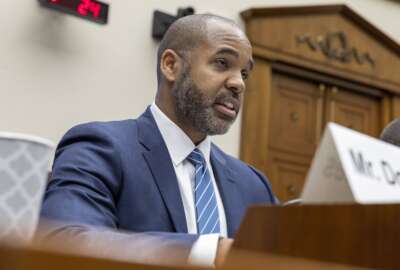Energy tests out hydrogen cars
The Department of Energy is testing out new hydrogen technology. Learn more about it through Federal News Radio\'s Greening of Government series.
wfedstaff | June 3, 2015 2:50 pm
By Olivia Branco
Federal News Radio
You may be driving a hybrid vehicle around, and while that may be better than a traditional gasoline car, there is even newer technology out that the Department of Energy is testing out.
The new technology? Cars fueled by hydrogen.
As part of Federal News Radio’s Greening of Government series, Sunita Satyapal, program manager for the Office of Hydrogen and Fuel Cell technologies at the Department of Energy, joined Chris Dorobek on The DorobekINSIDER to talk about the Department’s work and to give more information on the technology.
“Hydrogen and fuel cells are part of the overall portfolio of activities within DoE and industry has been looking at them for both vehicles like buses and light-duty vehicles, fork lifts, as well as stationary power like back up power or large powerplants,” Satyapal said. “Hydrogen and other fuels can be used in a fuel cell that can produce electricity directly without having any combustion so they’re much more efficient than for example you gasoline internal combustion engine.”
Patrick Serfass, the vice president of technology and communications for the National Hydrogen Association, also joined The DorobekINSIDER for the Greening of Government series, to give a more in depth look at hydrogen and its uses.
“You generally use it in a fuel cell, you can burn it in an engine just like you do gasoline or natural gas and some people are doing that but most people are using it in a fuel cell,” Serfass said. “A fuel cell is kind of like a continuous battery. It keeps supplying the fuel cell with hydrogen gas from a tank and oxygen from the air and it produces clean electricity with no emissions with a little bit of heat and water along with it.”
Where the hydrogen could affect the general population is with cars. Emissions that come from gasoline-powered cars can be overwhelming, however there are hydrogen cars that can eliminate emissions all together.
“There are some combustion engine vehicles that run on hydrogen but the majority that you’re hearing of are fuel cell vehicles,” Serfass said. “Since they put out electricity, they are electric vehicles. They run on full electricity, and when you hear of electric vehicles, most people only think of the battery vehicles, but electric vehicles actually include battery vehicles and fuel cell vehicles and in many cases on the vehicle, you have both the battery and the fuel cell providing the electricity to the motor which is what drives your wheels.”
But Serfass explained that it’s not just cars that hydrogen can be used for.
“The biggest ways hydrogen is used today is industrial uses. Making everything from literally peanut butter to rocket fuel. We use millions and millions of kilograms of it in the U.S. every year. But expanding the use of hydrogen from those industrial uses to be able to use it to power your vehicle, a bus, fuel cells which make electricity that you can power everything from your cell phone to your neighborhood there are tons of different applications.
“Each one of these applications are at a different stage of commercial readiness so while you might not be able to buy a vehicle today, you could buy a fuel cell and there are lots of companies that are doing so.”
Satyapal explained that the Department of Energy is continuing it’s research and they are hoping to lower the costs of hydrogen. One gallon of gasoline runs about $2-4.
“And it turns out that one gallon of gasoline has about the same energy content as a kilogram of hydrogen. So we need to be at about the same, about $2-4 per kilogram of hydrogen. We’re getting there, but we still need more to go but we have reduced the cost of the fuel cell itself by about 80%.”
While the Department of Energy continues it’s research, Serfass explained other ways that government could get involved with hydrogen. He explained that providing incentives, similar to the ones for hybrid vehicles, could help encourage people and companies to buy.
“There are incentives that can be put into place that Congress can help with but also on the federal government side helping to buy a large number of fuel cells to provide power to buildings and emergency power to critical facilities like the National Weather Service and safety and police, hospitals, and also buying vehicles in large fleets where these fleets of vehicles can fuel at a central facility around the agency are great ways to jumpstart the industry,” Serfass said.
“it’s going to help to make sure that the technology that are available to us as every day consumers are more advanced and cheaper and therefore affordable.”
Copyright © 2025 Federal News Network. All rights reserved. This website is not intended for users located within the European Economic Area.





